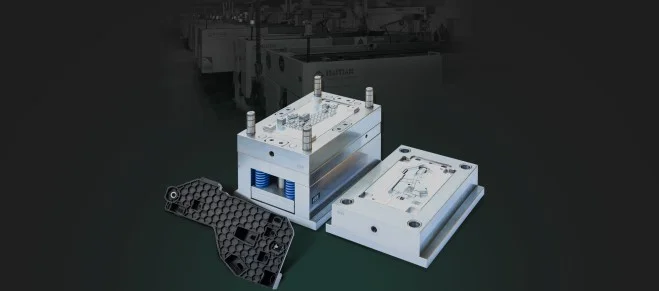Time to read: 11 min
Injection molding is a fast and efficient way to prototype and produce complex plastic parts for medical, aerospace, and other applications. Although it’s well-known and widely used, injection molding has its challenges, just like any manufacturing process.
For example, some injection molders may struggle to achieve consistent product quality. It’s also difficult to achieve and maintain compliance with quality standards such as ISO 13485 for medical device manufacturing and AS 9100 for the aerospace industry.

Process Traceability and the Digital Thread
Many injection molding problems can be attributed to a lack of traceability. In manufacturing, process traceability involves documenting and tracking all aspects of production, from inspecting raw materials to checking the quality of finished products.
That’s where the digital thread for process traceability comes in. By using digital tools and technologies to capture and analyze the flow of actionable information, injection molders can achieve greater quality in manufacturing. As a part designer, that benefits you as well.
What You’ll Learn
This article examines process traceability and explains how the digital thread in injection molding can improve part quality and manufacturing efficiency. For part designers, benefits range from better vendor communications to less material waste.
Keep reading to learn more, or visit Fictiv’s Injection Molding Services page to see our capabilities.

Understanding Process Traceability
Process traceability involves documenting and tracking each step of a product’s journey through manufacturing. Injection molders can identify defects as early and as close as possible to the point of origin, improving quality and reducing costs. Process records are required, however.
Process Records
Process records are a key part of the digital thread that injection molders use to identify and correct production issues. These digitized records help ensure consistent part quality while reducing the risk that defective products reach the marketplace.
In addition, process records help injection molders demonstrate compliance with quality management system (QMS) requirements. These traceability records also help protect intellectual property by tracking the flow of controlled information, such as part designs.
Product Lifecycle Management
The monitoring involved in process traceability can strengthen overall product lifecycle management (PLM). Designers can get products to markets more efficiently, and they can also expect better communication with vendors and a more collaborative approach to problem-solving.
With injection molding, traceability involves more than production monitoring and quality control. Medical, aerospace, and other highly regulated applications may require traceability for batches used to produce injection molded parts.
If there’s a safety incident or a product recall, an injection molder may need to provide this information to the customer or regulators. That’s why in the medical and aerospace industries, material suppliers who offer batch-level certificates of analysis (COA) have an advantage.

Understanding the Digital Thread
Digital threads can speed, simplify, and streamline traceability. From design for manufacturing (DFM) to the injection molding process; from mold maintenance to a product’s end-of-life, the ideal digital thread is both comprehensive and seamless.
DFM Feedback and IIoT
During the product development process, a designer who works with Fictiv can receive online DFM feedback from our engineering experts. Using the Fictiv platform, designers can also rotate virtual representations of their parts on-screen to view key details.
Among Fictiv’s manufacturing partners, digital threads can connect machine-based technologies that use the Industrial Internet of Things (IIoT) to online platforms where injection molders can monitor and manage processes and equipment in real time.
Planning and Maintenance
Digital threads can also be used for planning. For example, an injection molder can receive a customer’s sales forecast and use this information within its material requirements planning (MRP) system to determine reorder points.
Additionally, the digital thread can indicate when mold maintenance is recommended or required based on the number of production cycles. That’s important for part quality and inspections since worn tooling can contribute to injection molding defects such as flash.
Traceability Beyond Production
If the digital thread extends to the customer, it’s even possible to analyze information about product returns. With injection molded plastics, end-of-life concerns such as recycling can support environmental sustainability initiatives.
Digitized traceability can ensure that every authorized stakeholder with an Internet connection has access to accurate, up-to-date information. That’s a lot more efficient than mailing paper documents or sorting through email attachments, but what does a digital thread require?
Implementing a Digital Thread for Process Traceability
Implementing a digital thread requires integrating various data streams. Data must be captured, integrated, and assessed at every point in the injection molding process, including part design, material selection, and product samples.
This real-time, data-driven approach enables manufacturers to make corrections on the fly. For example, if there’s a problem in production, following the digital thread can help an injection molder identify the source of the issue, such as temperature or pressure.
Quick fixes can prevent bigger and more expensive problems, but there are benefits beyond the quality of the job that’s currently running on an injection molding machine. By reviewing historical data, injection molders can also plan maintenance and avoid unexpected downtime.
Digital threads also hold together smart factories, facilities where Internet of Things (IoT) technologies enable companies to continuously monitor and manage every aspect of a process – even with “lights out” manufacturing that doesn’t require human intervention.

Key Technologies Enabling a Digital Thread
Injection molders use these technologies to enable the digital thread.
- Cloud computing
- Edge computing
- Data analytics
- Artificial intelligence
- IIoT sensors
Importantly, all of these technologies can work together.
Cloud Computing
Cloud computing is the delivery of computing resources such as storage, servers, and databases over the Internet. It provides the storage and processing power that’s needed to deliver large amounts of data to a distributed group of users.
Edge Computing
Edge computing moves processing and data storage closer to the devices (such as an injection molding machine) that produce and consume the data. It can improve application performance, reduce bandwidth requirements, and provide faster real-time insights.
Data Analytics
Data analytics is the process of collecting, analyzing, and interpreting data to find trends, patterns, and correlations. By converting raw data into actionable insights, it enables injection molders to make decisions that can improve part quality and production efficiency.
Artificial Intelligence
Artificial intelligence (AI) enables computers and machines to simulate human learning, comprehension, and problem-solving. Machine learning (ML), a subset of AI, can be used for tasks such as predicting equipment failures based on previous machine conditions.
IIoT Sensors
Industrial Internet of Things (IIoT) sensors collect real-time data from machines and processes. These devices are installed on equipment and send information to the digital thread, ensuring that this information can be used in decision-making.

Benefits of Process Traceability in Injection Molding
There are three main benefits to implementing process traceability in injection molding.
- Quality assurance
- Production optimization
- Cost containment
The following sections explain how they help both the injection molder and the part designer.
Quality Assurance
Injection molders who continuously track production parameters and quality data can ensure that each part meets a project’s requirements. This reduces the incidence of defects and non-conformance while helping keep project timetables on track.
Production Optimization
Process traceability also helps optimize production. Injection molders who analyze current and historical data can identify bottlenecks, inefficiencies, and opportunities for improvement. Ultimately, this continuous feedback loop supports faster and more efficient operations.
Cost Containment
Injection molders need to produce quality parts while minimizing labor and material costs. By using the digital thread for process traceability, molders can make decisions such as when to add workers to a shift or which parameters to monitor more closely with a specific material.

Challenges in Implementing Process Traceability
There are three main challenges to implementing process traceability in injection molding.
- Data integration
- Cybersecurity
- Complexity
Injection molders need to meet these challenges, but part designers also have a role to play.
Data Integration
Some manufacturers use a combination of legacy systems and modern technologies. This can make it difficult to achieve a seamless flow of data throughout the digital thread. When data integration is possible, an injection molder may need to invest in upgrades or custom solutions.
Careful planning is important, and investments in scalable and future-proof technologies can help injection molders to realize a return on investment (ROI). Part designers who become part of the digital thread may also need to adjust their current practices to support data integration.
Cybersecurity
Digital threads create more connected environments, which increases the risk of cyber incidents. Vulnerabilities can be protected, but injection molders must adopt security measures such as access controls and data encryption.
Compliance with a specific cybersecurity standard may not be required, but it’s still important for an injection molder to perform regular audits of cyber practices. Designers want to know their CAD files are secure, but their own computer systems also require cybersecurity.
Complexity
The complexity of securing the digital thread increases with the number of stakeholders, especially when suppliers and other partners are part of an injection molder’s processes. By taking a holistic approach, injection molders can ensure the benefits outweigh the risks.
Integrating legacy systems or practices with newer technologies can introduce security weaknesses, however, especially when older technologies (such as server operating systems) cannot meet newer requirements such as compliance with cybersecurity standards.

The Importance of Traceability in Manufacturing
Note: David Woodward, Fictiv Director of Quality, contributed this section of the article. He is a winner of a 2022 Pros to Know award from Supply Chain & Demand Executive.
Traceability of manufactured parts is an important requirement, particularly in regulated industries. However, the effectiveness and efficiency of doing this is not well understood.
Typically, the requirement for traceability is the ability to identify which products have potential issues and then being able to determine where these products are. The two most common approaches to traceability are the lot number and the serial number; however, other methods are also used (e.g., an auto manufacturer recalling vehicles by model/year).
Lot Numbers
Lot numbers, in my experience, don’t get enough thought put into them. Lots can be determined based on manufacturing start dates, manufacturing end dates, inspection/test dates, shipping dates, dates through a specific process, lots that are coincident with the lot of a critical component used in the supplier’s product, subcontracted lots, etc.
Usually, a customer just asks a supplier to provide a lot number without providing any guidance regarding how the lot should be defined. As we will see, how that lot is defined can have a significant impact at the time it is needed by the customer.
Serial Numbers
Serial numbers on each part, assembly, or product brings more granularity to traceability and can prove useful for the manufacturer in collecting data and performing in-plant analysis. In a business-to-business situation, the receiver can use serialized parts or assemblies to support the traceability of their products.
In a business-to-consumer environment, when a consumer has a problem, a serial number (or a lot number) will be the first step in identifying what the cause of the failure is and, for the business, just how widespread the issue could be.
Recalls
In my career, I have suffered through only a small number of recalls, but in these cases both lot and serial number traceability played a smaller part in driving actions than you might think.
In one situation at a former company, we identified a problem with some products that we had on extended test, where their performance would deteriorate with time. It wasn’t a hard failure, but it was still a failure that would negatively affect the revenue collecting capabilities of our customers.
The products were all serialized and we shipped them in lots. We were able to identify the source of the failure: a particular purchased component. It was easy enough to identify the purchase lots of the faulty component, but we did not track these lots to the products we were manufacturing. (Our products had hundreds of components, so tracking every one of them would have been very costly.)
Fortunately, because we used a first-in, first-out (FIFO) stock management system, we were confident that the suspect components were all used sequentially. So, by knowing how many we had purchased and counting how many we still had in inventory, we were able to identify how many had shipped.
By analyzing the shipping and manufacturing history, we were able to identify which shipping lots had the bad components, so we issued a recall for them. Some of the early lots would have had good components, but this was about erring on the safe side for the customer, but not by a significant amount in the grand scheme of things.
In another situation, at a different former company, we had a similar component problem, but this was a simple spring-washer and, although we used FIFO, we knew the factory usage model was to tip these into tote bins as they started getting low in inventory. Again, by simple math we were able to identify which products were affected.
This time, however, the margin of error was greater and, because there were potential safety issues associated with the failure, we recalled far more product than was necessary. (The product was serialized and, although it may have proved useful to our customer to perform their own recall and inventory check, it was of no use to us.)
Lessons Learned
There were three major lessons learned.
Lots and Risk-Based Thinking
When defining lots, do it with risk-based thinking. If you think the most likely cause of failure is going to be with a subcontracted process, then align your lot/serial numbers with the parts your subcontractor processes. Take care to understand how their process works.
If you send a hundred parts to a subcontractor but they process them in jobs of 20 each, then you might want to consider your lot size as 20 and not 100. Ask the subcontractor to bag and tag the 5 lots of 20 individually
Murphy’s Law
No matter how well you evaluate the risks, assume Murphy’s Law will apply when you need to do a recall and that lot numbers and serial numbers will not help you. Good inventory control will be your savior along with the application of some basic math.
Implementing some disciplines with a recall in mind (for instance, not topping-up tote bins but completely emptying the old one before starting the new) will pay dividends. Otherwise, depending on the severity of the consequences, you may recall far more products than you or your customer need to.
Costs
Recalling too many products is one cost, but applying too much detail in tracking different components and/or processes can be costly as well. If Murphy’s Law kicks in, as above, then this will be a high insurance premium for a policy which might not pay out. Establishing discipline in manufacturing processes has the best payback, not just for traceability issues, but so many other aspects of manufacturing too.
Traceability: Tying It All Together
“Traceability in manufacturing is important in case something goes wrong,” says David Woodward, Fictiv’s Director of Quality, “but the cost of providing traceability for all eventualities needs to be considered carefully. It’s like paying an insurance premium that you’re confident you’ll never make a claim against.”
As a part designer, it pays to partner with a company that works with a carefully vetted network of manufacturers, including injection molders with ISO 13485 or AS 9100 certifications. Plus, when you work with Fictiv, you’ll gain access to our online platform and receive DFM feedback along with your injection molding quote.
No matter what your manufacturing needs might be, Fictiv can help make any design a reality. To get started, create a Fictiv account and upload your design today!








